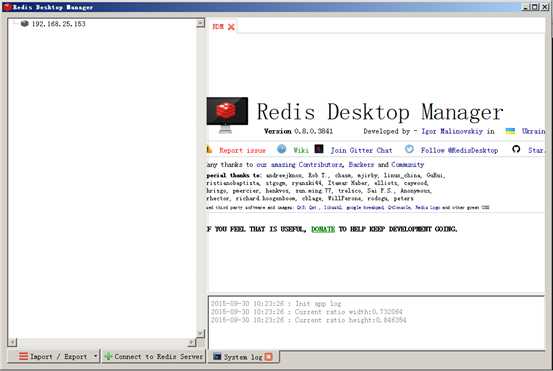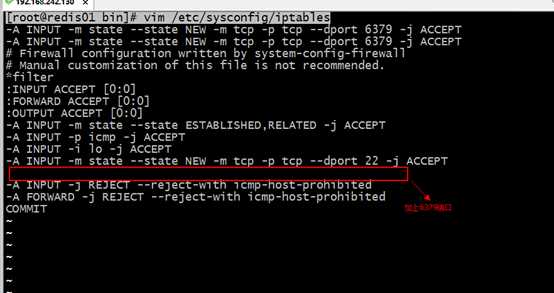Redis客户端
Posted ddqy
tags:
篇首语:本文由小常识网(cha138.com)小编为大家整理,主要介绍了Redis客户端相关的知识,希望对你有一定的参考价值。
1 Redis客户端

1.1 自带命令行客户端
l 命令格式:
|
./redis-cli -h 127.0.0.1 -p 6379 |
l 修改redis配置文件(解决IP绑定问题)
# bind 127.0.0.1 绑定的IP才能访问redis服务器,注释掉该配置
protected-mode yes 是否开启保护模式,由yes该为no
l 参数说明:
-h:redis服务器的ip地址
-p:redis实例的端口号
l 默认方式
如果不指定主机和端口也可以
|
./redis-cli |
*默认主机地址是127.0.0.1
* 默认端口是6379
1.2 图形界面客户端(了解)
前提:需要安装图形界面管理器

1.2.1连接超时解决
远程连接redis服务,需要关闭或者修改防火墙配置。
修改防火墙设置:
l 第一步:编辑iptables
|
vim /etc/sysconfig/iptables |
在命令模式下,选定要复制的那一行的末尾,然后点击键盘yyp,就完成复制,然后修改。

l 第二步:重启防火墙
|
service iptables restart iptables:清除防火墙规则: [确定] iptables:将链设置为政策 ACCEPT:filter [确定] iptables:正在卸载模块: [确定] iptables:应用防火墙规则: [确定] |
1.2.2多数据库支持
l 默认一共是16个数据库,每个数据库之间是相互隔离(但是可以使用flushall一次清空所有的库)。数据库的数量是在redis.conf中配置的。

l 切换数据库使用命令:select数据库编号(0-15)
例如:select 1
1.3 程序客户端之Java客户端Jedis
1.3.1Jedis介绍
l Redis不仅使用命令客户端来操作,而且可以使用程序客户端操作。
l 现在基本上主流的语言都有客户端支持,比如Java、C、C#、C++、php、Node.js、Go等。
l 在官方网站里列一些Java的客户端,有Jedis、Redisson、Jredis、JDBC-Redis、等其中官方推荐使用Jedis和Redisson。
l 在企业中用的最多的就是Jedis,下面我们就重点学习下Jedis。
l Jedis同样也是托管在github上,地址:https://github.com/xetorthio/jedis
1.3.2添加jar包
|
<dependency> <groupId>redis.clients</groupId> <artifactId>jedis</artifactId> <version>2.9.0</version> </dependency> |
1.3.3单实例连接
注意事项:需要去设置redis服务器的防火墙策略(临时关闭、永久关闭、端口暴露)
|
@Test publicvoid testJedis() { //创建一个Jedis的连接 Jedis jedis = new Jedis("127.0.0.1", 6379); //执行redis命令 jedis.set("key1", "hello world"); //从redis中取值 String result = jedis.get("key1"); //打印结果 System.out.println(result); //关闭连接 jedis.close();
} |
1.3.4连接池连接
|
@Test publicvoid testJedisPool() { //创建一连接池对象 JedisPool jedisPool = new JedisPool("127.0.0.1", 6379); //从连接池中获得连接 Jedis jedis = jedisPool.getResource(); String result = jedis.get("key1") ; System.out.println(result); //关闭连接 jedis.close();
//关闭连接池 jedisPool.close(); } |
1.3.5Spring整合JedisPool(自学)
添加spring的jar包
l 配置spring配置文件applicationContext.xml
|
<?xml version="1.0" encoding="UTF-8"?> <beans xmlns="http://www.springframework.org/schema/beans" xmlns:xsi="http://www.w3.org/2001/XMLSchema-instance" xmlns:mvc="http://www.springframework.org/schema/mvc" xmlns:context="http://www.springframework.org/schema/context" xmlns:aop="http://www.springframework.org/schema/aop" xmlns:tx="http://www.springframework.org/schema/tx" xsi:schemaLocation="http://www.springframework.org/schema/beans http://www.springframework.org/schema/beans/spring-beans.xsd http://www.springframework.org/schema/mvc http://www.springframework.org/schema/mvc/spring-mvc.xsd http://www.springframework.org/schema/context http://www.springframework.org/schema/context/spring-context.xsd http://www.springframework.org/schema/aop http://www.springframework.org/schema/aop/spring-aop.xsd http://www.springframework.org/schema/tx http://www.springframework.org/schema/tx/spring-tx.xsd ">
<!-- 连接池配置 --> <bean id="jedisPoolConfig" class="redis.clients.jedis.JedisPoolConfig"> <!-- 最大连接数 --> <property name="maxTotal" value="30" /> <!-- 最大空闲连接数 --> <property name="maxIdle" value="10" /> <!-- 每次释放连接的最大数目 --> <property name="numTestsPerEvictionRun" value="1024" /> <!-- 释放连接的扫描间隔(毫秒) --> <property name="timeBetweenEvictionRunsMillis" value="30000" /> <!-- 连接最小空闲时间 --> <property name="minEvictableIdleTimeMillis" value="1800000" /> <!-- 连接空闲多久后释放, 当空闲时间>该值 且 空闲连接>最大空闲连接数 时直接释放 --> <property name="softMinEvictableIdleTimeMillis" value="10000" /> <!-- 获取连接时的最大等待毫秒数,小于零:阻塞不确定的时间,默认-1 --> <property name="maxWaitMillis" value="1500" /> <!-- 在获取连接的时候检查有效性, 默认false --> <property name="testOnBorrow" value="false" /> <!-- 在空闲时检查有效性, 默认false --> <property name="testWhileIdle" value="true" /> <!-- 连接耗尽时是否阻塞, false报异常,ture阻塞直到超时, 默认true --> <property name="blockWhenExhausted" value="false" /> </bean>
<!-- redis单机 通过连接池 --> <bean id="jedisPool" class="redis.clients.jedis.JedisPool" destroy-method="close"> <constructor-arg name="poolConfig" ref="jedisPoolConfig" /> <constructor-arg name="host" value="192.168.242.130" /> <constructor-arg name="port" value="6379" /> </bean> </beans> |
l 测试代码
|
@Test publicvoid testJedisPool() { JedisPool pool = (JedisPool) applicationContext.getBean("jedisPool"); Jedis jedis = null; try { jedis = pool.getResource();
jedis.set("name", "lisi"); String name = jedis.get("name"); System.out.println(name); } catch (Exception ex) { ex.printStackTrace(); } finally { if (jedis != null) { // 关闭连接 jedis.close(); } } } |
1 Redis客户端
1.1 自带命令行客户端
l 命令格式:
|
./redis-cli -h 127.0.0.1 -p 6379 |
l 修改redis配置文件(解决IP绑定问题)
# bind 127.0.0.1 绑定的IP才能访问redis服务器,注释掉该配置
protected-mode yes 是否开启保护模式,由yes该为no
l 参数说明:
-h:redis服务器的ip地址
-p:redis实例的端口号
l 默认方式
如果不指定主机和端口也可以
|
./redis-cli |
*默认主机地址是127.0.0.1
* 默认端口是6379
1.2 图形界面客户端(了解)
前提:需要安装图形界面管理器
1.2.1连接超时解决
远程连接redis服务,需要关闭或者修改防火墙配置。
修改防火墙设置:
l 第一步:编辑iptables
|
vim /etc/sysconfig/iptables |
在命令模式下,选定要复制的那一行的末尾,然后点击键盘yyp,就完成复制,然后修改。
l 第二步:重启防火墙
|
service iptables restart iptables:清除防火墙规则: [确定] iptables:将链设置为政策 ACCEPT:filter [确定] iptables:正在卸载模块: [确定] iptables:应用防火墙规则: [确定] |
1.2.2多数据库支持
l 默认一共是16个数据库,每个数据库之间是相互隔离(但是可以使用flushall一次清空所有的库)。数据库的数量是在redis.conf中配置的。
l 切换数据库使用命令:select数据库编号(0-15)
例如:select 1
1.3 程序客户端之Java客户端Jedis
1.3.1Jedis介绍
l Redis不仅使用命令客户端来操作,而且可以使用程序客户端操作。
l 现在基本上主流的语言都有客户端支持,比如Java、C、C#、C++、php、Node.js、Go等。
l 在官方网站里列一些Java的客户端,有Jedis、Redisson、Jredis、JDBC-Redis、等其中官方推荐使用Jedis和Redisson。
l 在企业中用的最多的就是Jedis,下面我们就重点学习下Jedis。
l Jedis同样也是托管在github上,地址:https://github.com/xetorthio/jedis
1.3.2添加jar包
|
<dependency> <groupId>redis.clients</groupId> <artifactId>jedis</artifactId> <version>2.9.0</version> </dependency> |
1.3.3单实例连接
注意事项:需要去设置redis服务器的防火墙策略(临时关闭、永久关闭、端口暴露)
|
@Test publicvoid testJedis() { //创建一个Jedis的连接 Jedis jedis = new Jedis("127.0.0.1", 6379); //执行redis命令 jedis.set("key1", "hello world"); //从redis中取值 String result = jedis.get("key1"); //打印结果 System.out.println(result); //关闭连接 jedis.close();
} |
1.3.4连接池连接
|
@Test publicvoid testJedisPool() { //创建一连接池对象 JedisPool jedisPool = new JedisPool("127.0.0.1", 6379); //从连接池中获得连接 Jedis jedis = jedisPool.getResource(); String result = jedis.get("key1") ; System.out.println(result); //关闭连接 jedis.close();
//关闭连接池 jedisPool.close(); } |
1.3.5Spring整合JedisPool(自学)
添加spring的jar包
l 配置spring配置文件applicationContext.xml
|
<?xml version="1.0" encoding="UTF-8"?> <beans xmlns="http://www.springframework.org/schema/beans" xmlns:xsi="http://www.w3.org/2001/XMLSchema-instance" xmlns:mvc="http://www.springframework.org/schema/mvc" xmlns:context="http://www.springframework.org/schema/context" xmlns:aop="http://www.springframework.org/schema/aop" xmlns:tx="http://www.springframework.org/schema/tx" xsi:schemaLocation="http://www.springframework.org/schema/beans http://www.springframework.org/schema/beans/spring-beans.xsd http://www.springframework.org/schema/mvc http://www.springframework.org/schema/mvc/spring-mvc.xsd http://www.springframework.org/schema/context http://www.springframework.org/schema/context/spring-context.xsd http://www.springframework.org/schema/aop http://www.springframework.org/schema/aop/spring-aop.xsd http://www.springframework.org/schema/tx http://www.springframework.org/schema/tx/spring-tx.xsd ">
<!-- 连接池配置 --> <bean id="jedisPoolConfig" class="redis.clients.jedis.JedisPoolConfig"> <!-- 最大连接数 --> <property name="maxTotal" value="30" /> <!-- 最大空闲连接数 --> <property name="maxIdle" value="10" /> <!-- 每次释放连接的最大数目 --> <property name="numTestsPerEvictionRun" value="1024" /> <!-- 释放连接的扫描间隔(毫秒) --> <property name="timeBetweenEvictionRunsMillis" value="30000" /> <!-- 连接最小空闲时间 --> <property name="minEvictableIdleTimeMillis" value="1800000" /> <!-- 连接空闲多久后释放, 当空闲时间>该值 且 空闲连接>最大空闲连接数 时直接释放 --> <property name="softMinEvictableIdleTimeMillis" value="10000" /> <!-- 获取连接时的最大等待毫秒数,小于零:阻塞不确定的时间,默认-1 --> <property name="maxWaitMillis" value="1500" /> <!-- 在获取连接的时候检查有效性, 默认false --> <property name="testOnBorrow" value="false" /> <!-- 在空闲时检查有效性, 默认false --> <property name="testWhileIdle" value="true" /> <!-- 连接耗尽时是否阻塞, false报异常,ture阻塞直到超时, 默认true --> <property name="blockWhenExhausted" value="false" /> </bean>
<!-- redis单机 通过连接池 --> <bean id="jedisPool" class="redis.clients.jedis.JedisPool" destroy-method="close"> <constructor-arg name="poolConfig" ref="jedisPoolConfig" /> <constructor-arg name="host" value="192.168.242.130" /> <constructor-arg name="port" value="6379" /> </bean> </beans> |
l 测试代码
|
@Test publicvoid testJedisPool() { JedisPool pool = (JedisPool) applicationContext.getBean("jedisPool"); Jedis jedis = null; try { jedis = pool.getResource();
jedis.set("name", "lisi"); String name = jedis.get("name"); System.out.println(name); } catch (Exception ex) { ex.printStackTrace(); } finally { if (jedis != null) { // 关闭连接 jedis.close(); } } } |
以上是关于Redis客户端的主要内容,如果未能解决你的问题,请参考以下文章